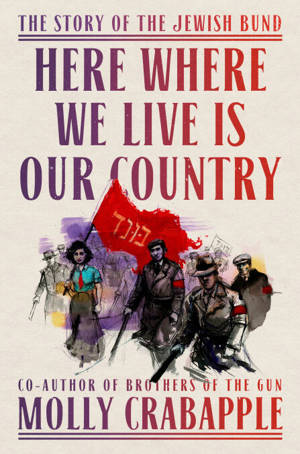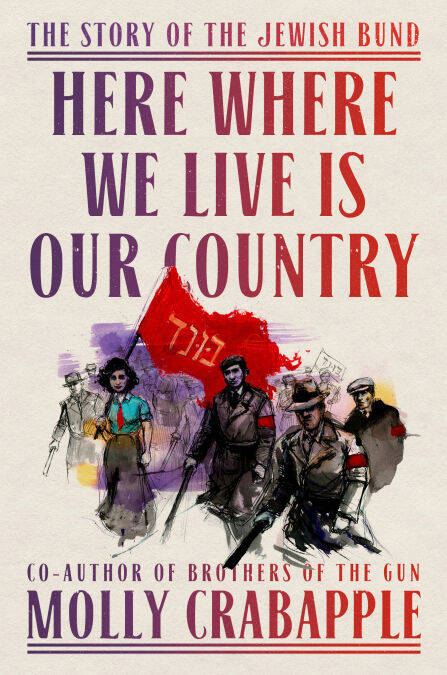
- Afhalen na 1 uur in een winkel met voorraad
- Gratis thuislevering in België vanaf € 30
- Ruim aanbod met 7 miljoen producten
- Afhalen na 1 uur in een winkel met voorraad
- Gratis thuislevering in België vanaf € 30
- Ruim aanbod met 7 miljoen producten
Zoeken
Here Where We Live Is Our Country E-BOOK
The Story of the Jewish Bund
Molly Crabapple
E-book | Engels
€ 16,12
+ 16 punten
Uitvoering
Omschrijving
The dramatic story of the Jewish Bund—a revolutionary movement from a vanished world—and their radical vision of solidarity in an age of division.
“Molly Crabapple beckons readers through a portal to an irresistible, lost world, one bound together by passion, solidarity, and a burning hunger for justice.”—Naomi Klein, New York Times bestselling author of No Logo and Doppelganger
When artist Sam Rothbort created his “Memory Paintings” in the aftermath of the Holocaust, he was trying to resurrect the vanished world of his shtetl childhood. When his great-granddaughter, the award-winning artist and journalist Molly Crabapple, discovered his archives decades later, one painting stood out: a girl, her dress the same color as the sky above, hurling a rock through a cottage window. Itka the Bundist, Breaking Windows.
That single painting sent Crabapple on a journey into the Jewish Labor Bund. Once the most influential Jewish political force in eastern Europe—and a player in some of the most important events of the twentieth century—they were secular, socialist, and uncompromisingly anti-Zionist. They fought for dignity and equality, not in an imagined homeland in Palestine, but “here, where we live.”
In the first popular history of the Bund, Crabapple recreates their extraordinary world through dramatic portraits of leaders and foot soldiers alike. The characters Crabapple brings to such vivid life—insurgent poets and anti-religious rebels, clandestine revolutionaries and lovers on the barricades—live deeply through this violent, volatile, and somehow hopeful period, their stories intimately bound up with the Russian Revolution and the Holocaust. Crabapple also grapples with the vital question raised by their rise and fall: What can we learn from a movement that, for all its toughness, imagination, and moral clarity, was largely destroyed?
With intimate portraiture and sweeping history, Here Where We Live Is Our Country reanimates a band of idealists who broadened our global political imagination. As we once again contend with nationalism, repression, and the struggle for belonging, the Bund’s remarkable story and message—that liberation, dignity, and solidarity must begin where we stand—reaches across time as a guide to our own urgent moment.
“Molly Crabapple beckons readers through a portal to an irresistible, lost world, one bound together by passion, solidarity, and a burning hunger for justice.”—Naomi Klein, New York Times bestselling author of No Logo and Doppelganger
When artist Sam Rothbort created his “Memory Paintings” in the aftermath of the Holocaust, he was trying to resurrect the vanished world of his shtetl childhood. When his great-granddaughter, the award-winning artist and journalist Molly Crabapple, discovered his archives decades later, one painting stood out: a girl, her dress the same color as the sky above, hurling a rock through a cottage window. Itka the Bundist, Breaking Windows.
That single painting sent Crabapple on a journey into the Jewish Labor Bund. Once the most influential Jewish political force in eastern Europe—and a player in some of the most important events of the twentieth century—they were secular, socialist, and uncompromisingly anti-Zionist. They fought for dignity and equality, not in an imagined homeland in Palestine, but “here, where we live.”
In the first popular history of the Bund, Crabapple recreates their extraordinary world through dramatic portraits of leaders and foot soldiers alike. The characters Crabapple brings to such vivid life—insurgent poets and anti-religious rebels, clandestine revolutionaries and lovers on the barricades—live deeply through this violent, volatile, and somehow hopeful period, their stories intimately bound up with the Russian Revolution and the Holocaust. Crabapple also grapples with the vital question raised by their rise and fall: What can we learn from a movement that, for all its toughness, imagination, and moral clarity, was largely destroyed?
With intimate portraiture and sweeping history, Here Where We Live Is Our Country reanimates a band of idealists who broadened our global political imagination. As we once again contend with nationalism, repression, and the struggle for belonging, the Bund’s remarkable story and message—that liberation, dignity, and solidarity must begin where we stand—reaches across time as a guide to our own urgent moment.
Specificaties
Betrokkenen
- Auteur(s):
- Uitgeverij:
Inhoud
- Aantal bladzijden:
- 480
- Taal:
- Engels
Eigenschappen
- Productcode (EAN):
- 9780593229460
- Verschijningsdatum:
- 6/04/2026
- Uitvoering:
- E-book
- Beveiligd met:
- Adobe DRM
- Formaat:
- ePub

Alleen bij Standaard Boekhandel
+ 16 punten op je klantenkaart van Standaard Boekhandel
Beoordelingen
We publiceren alleen reviews die voldoen aan de voorwaarden voor reviews. Bekijk onze voorwaarden voor reviews.








